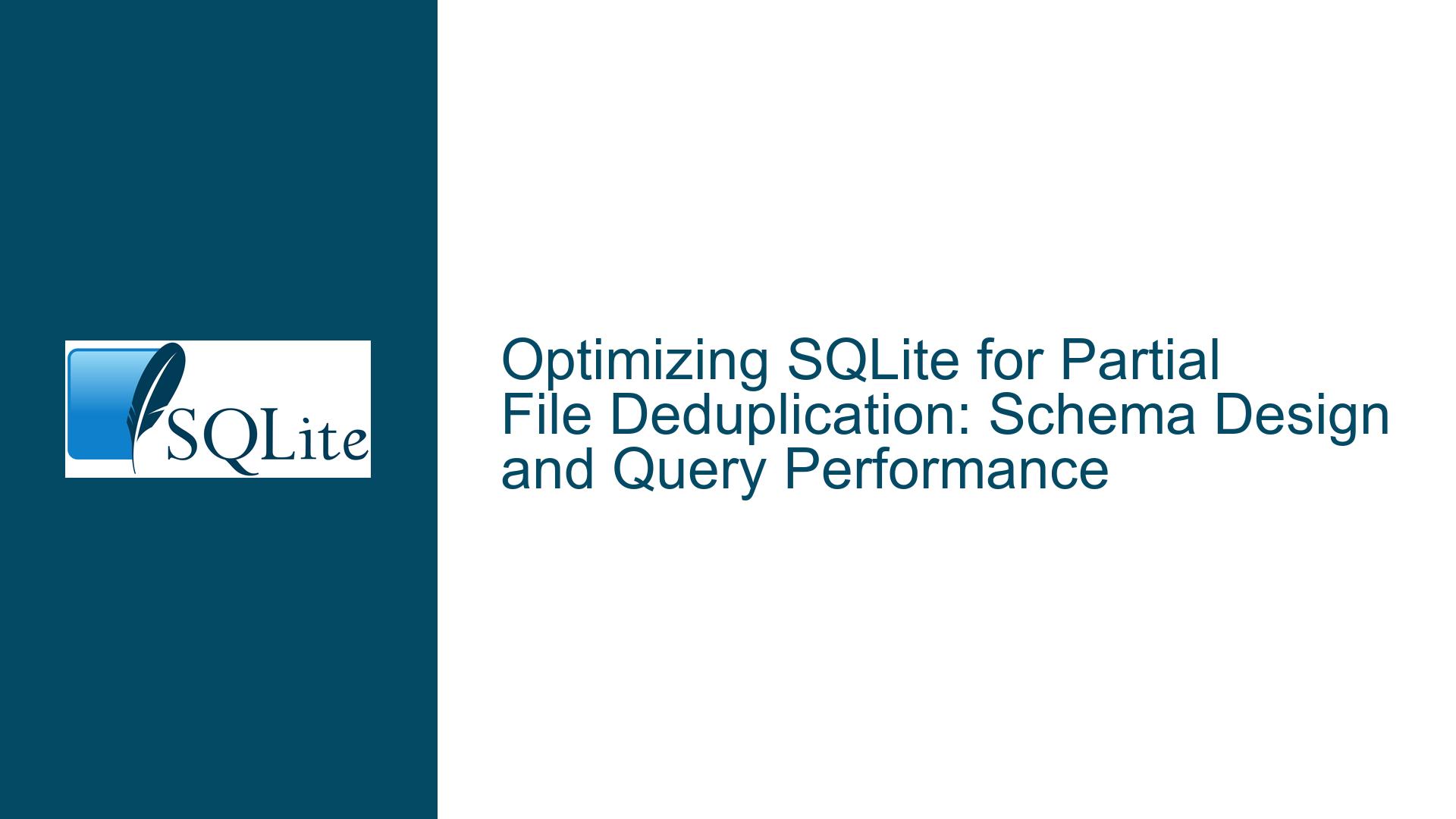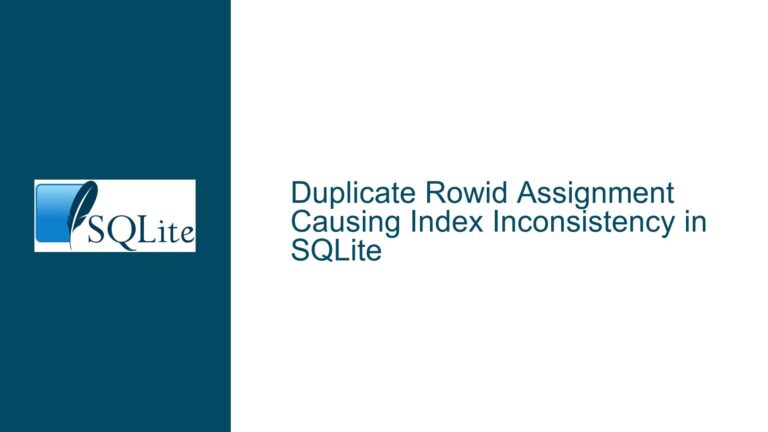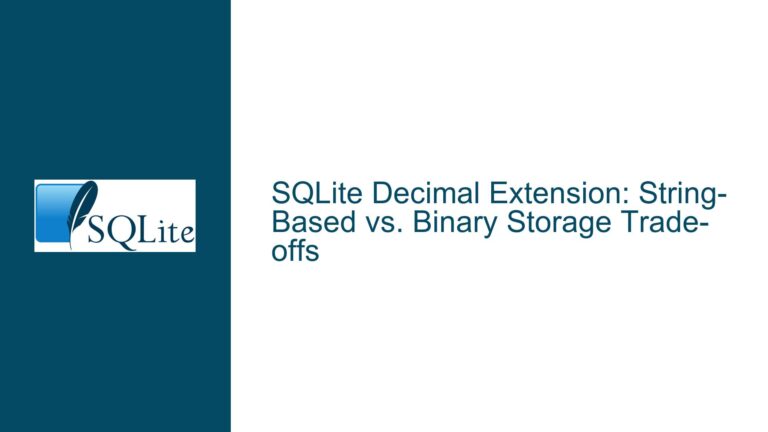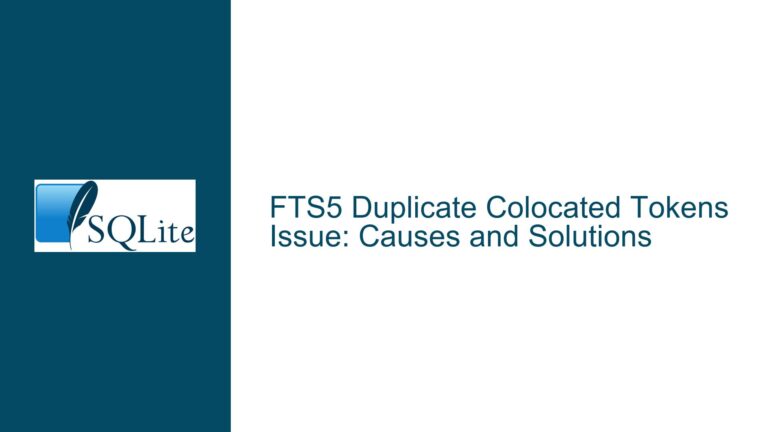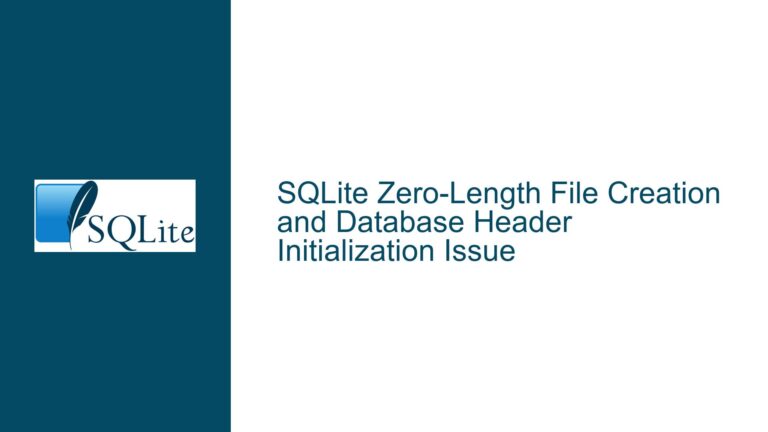Optimizing SQLite for Partial File Deduplication: Schema Design and Query Performance
Issue Overview: Partial File Deduplication in SQLite with Block-Level Hashing
The core issue revolves around implementing a partial file deduplication system using SQLite, where the goal is to identify and leverage common blocks of data across files to save disk space. The system is designed to track files and their constituent blocks, each identified by a cryptographic hash. The schema includes a file table to store metadata about files (such as size and modification date) and a block table to store block-level hashes for each file. A temporary table, newblock, is used during the insertion of new files to compute and compare block hashes against existing data.
The primary challenge lies in efficiently querying the database to identify files with the most common blocks, which is critical for determining the best candidate for deduplication. The initial query performance degrades significantly as the database grows, necessitating the use of statistics and indexing strategies to maintain acceptable performance. The schema design and query optimization are tightly coupled, as the choice of indexes and the structure of the queries directly impact the system’s ability to scale.
The system’s effectiveness is measured by the number of blocks saved through deduplication, compared to the overhead of maintaining the database. The results show that the complex approach, while requiring more storage for the database itself, ultimately saves more disk space than a simpler alternative that only tracks file-level hashes.
Possible Causes: Performance Degradation and Schema Complexity
The performance issues in this system stem from several interrelated factors. First, the absence of proper indexing and statistics in the initial implementation leads to inefficient query execution. The query plan reveals that the database engine resorts to full table scans and temporary B-tree structures for sorting and grouping, which are computationally expensive operations, especially as the dataset grows.
The schema design, while elegant in its ability to track block-level hashes, introduces complexity that can hinder performance. The block table, which stores hashes for each block of each file, becomes large quickly, and queries that join this table with the newblock table require careful optimization. The lack of a covering index on the block table initially forces the database to perform additional lookups, further slowing down the query.
Another potential cause of performance degradation is the use of cryptographic hashes, which, while ensuring data integrity, are computationally intensive to generate and compare. Truncating these hashes to 64 bits and reinterpreting them as integers helps mitigate this issue, but the trade-off between hash size and collision probability must be carefully considered.
The temporary newblock table, while useful for staging new data, adds overhead to the insertion process. Each new file requires computing hashes for all its blocks, inserting them into newblock, and then performing a join with the block table to identify matches. This process can become a bottleneck, particularly when dealing with large files or a high volume of insertions.
Finally, the system’s reliance on macOS-specific features, such as file ID lookups, introduces platform dependencies that may limit its portability. While this is not a direct cause of performance issues, it is a design consideration that could affect the system’s applicability in other environments.
Troubleshooting Steps, Solutions & Fixes: Optimizing Schema and Queries for Scalability
To address the performance issues and ensure the system scales effectively, several optimizations can be implemented. These include refining the schema design, improving indexing strategies, and optimizing queries to reduce computational overhead.
Schema Refinements
The existing schema is well-suited for tracking block-level hashes, but minor adjustments can improve performance. For example, the block table uses a composite primary key on fileid and blockix, which is efficient for lookups but can be further optimized by ensuring that the hash column is indexed appropriately. Adding a covering index on (hash, blockix) allows the database to satisfy queries directly from the index, avoiding the need to access the underlying table.
The newblock table, being temporary, does not require persistent storage, but its structure can be optimized for faster inserts and lookups. Using WITHOUT ROWID for this table, as done with the block table, can reduce storage overhead and improve access times.
Indexing Strategies
The initial query plan highlights the importance of indexing for performance. The block_hash_ix index on (hash, blockix) is critical for efficient joins between the block and newblock tables. However, the database must also maintain statistics on these indexes to generate optimal query plans. Running ANALYZE periodically ensures that the query planner has up-to-date information about the distribution of data, enabling it to choose the most efficient execution strategy.
In addition to the existing indexes, consider adding an index on the file table’s moddate column if queries frequently filter files based on modification time. This can further reduce the number of rows scanned during query execution.
Query Optimization
The core query for identifying files with the most common blocks can be optimized by breaking it into smaller, more manageable steps. For example, precomputing the count of matching blocks for each file and storing the results in a temporary table can simplify the final query. This approach reduces the complexity of the WITH clause and allows the database to focus on sorting and limiting the results.
Another optimization is to use window functions to rank files based on the number of matching blocks. This eliminates the need for a separate subquery to determine the file with the most matches, streamlining the query execution.
Hash Function Considerations
While BLAKE3 is a robust choice for cryptographic hashing, its computational cost can be a bottleneck. Consider using a faster non-cryptographic hash function, such as xxHash or MurmurHash, for the initial block comparisons. These functions provide sufficient collision resistance for this use case while significantly reducing computation time. Cryptographic hashes can still be used for final verification if needed.
Platform Independence
To make the system more portable, replace macOS-specific features like file ID lookups with platform-agnostic alternatives. For example, storing file paths in the file table and using them for lookups ensures compatibility across different operating systems. This change may require additional logic to handle path normalization and case sensitivity, but it broadens the system’s applicability.
Monitoring and Maintenance
Finally, implement monitoring and maintenance routines to ensure the system remains performant over time. Regularly analyze query performance using EXPLAIN QUERY PLAN and adjust indexes or queries as needed. Periodically vacuum the database to reclaim unused space and defragment tables and indexes. These practices help maintain optimal performance as the dataset grows.
By addressing these areas, the system can achieve its goal of efficient partial file deduplication while maintaining scalability and performance. The trade-offs between schema complexity, query optimization, and computational overhead must be carefully balanced to ensure the system remains effective in real-world scenarios.
This post provides a comprehensive analysis of the issues, their causes, and actionable solutions for optimizing SQLite-based partial file deduplication systems. By following these recommendations, developers can build scalable and efficient solutions for managing disk space through advanced deduplication techniques.
